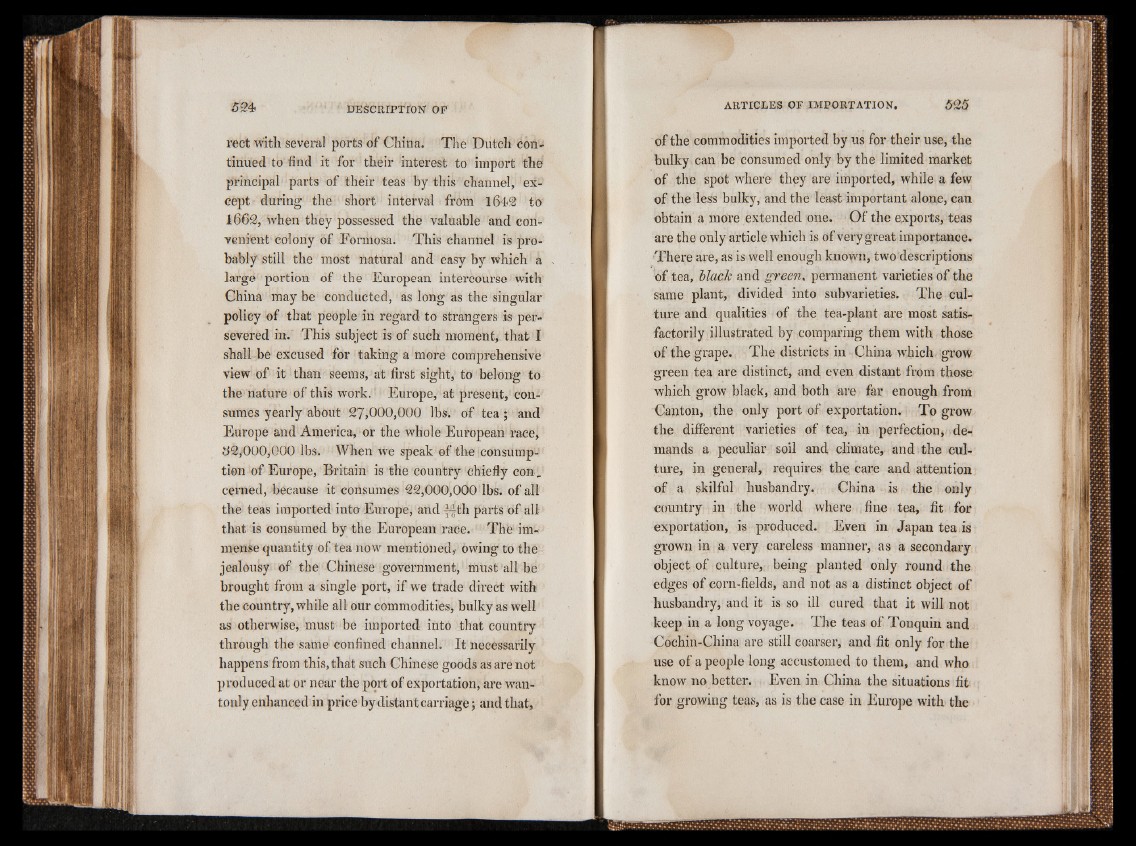
rect with several ports of China. The Dutch con*
tinued to find it for their interest to import the
principal parts of their teas by this channel, except
during the short interval from 1642 to
1662, when they possessed the valuable and convenient
colony of Formosa. This channel is probably
still the most natural and easy by which a
large portion of the European intercourse with
China may be conducted, as long as the singular
policy of that people in regard to strangers is persevered
in. This subject is of such moment, that I
shall be excused for taking a more comprehensive
view of it than seems, at first sight, to belong to
the nature of this work. Europe, at present, consumes
yearly about 2 7 ,000,000 lbs. of tea ; and
Europe and America, or the whole European race,
32,000,000 lbs. When we speak of the consumption
of Europe, Britain is the country chiefly con .
cerned, because it consumes 22,000,000 lbs. of all
the teas imported into Europe, and ifth parts of all
that is consumed by the European race. The immense
quantity of tea now mentioned, owing to the
jealousy of the Chinese government, must all be
brought from a single port, if we trade direct with
the country, while all our commodities, bulky as well
as otherwise, must be imported into that country
through the same confined channel. It necessarily
happens from this, that such Chinese goods as are not
produced at or near the port of exportation, are wantonly
enhanced in price by distant carriage j and that,
of the commodities imported by us for their use, the
bulky can be consumed only by the limited market
of the spot where they are imported, while a few
of the less bulky, and the least important alone, can
obtain a more extended one. Of the exports, teas
are the only article which is of very great importance.
There are, as is well enough known, two descriptions
of tea, black and green, permanent varieties of the
same plant, divided into subvarieties. The culture
and qualities of the tea-plant are most satisfactorily
illustrated by comparing them with those
of the grape. The districts in China which grow
green tea are distinct, and even distant from those
which grow black, and both are far enough from
Canton, the only port of exportation. To grow
the different varieties of tea, in perfection, demands
a peculiar soil and climate, and the culture,
in general, requires the care and attention
of a skilful husbandry. China is the only
country in the world where fine tea, fit for
exportation, is produced.; Even in Japan tea is
grown in a very careless manner, as a secondary
object of culture, being planted only round the
edges of corn-fields, and not as a distinct object of
husbandry, and it is so ill cured that it will not
keep in a long voyage. The teas of Tonquin and
Cochin-China are still coarser, and fit only for the
use of a people long accustomed to them, and who
know no better. Even in China the situations fit
for growing teas, as is the case in Europe with the